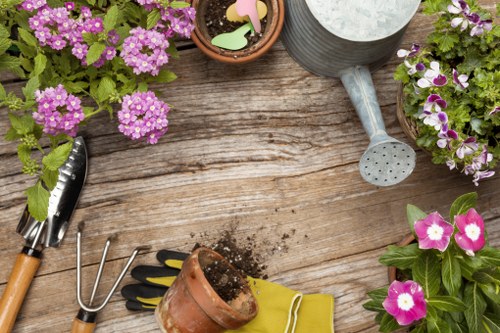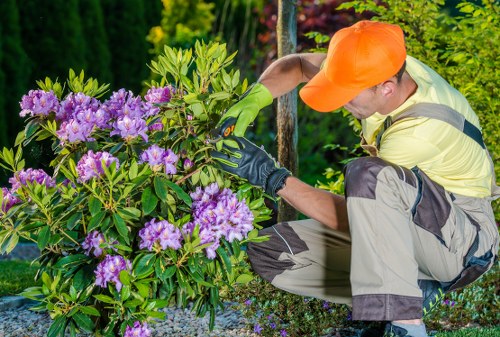Lawn Mowing Leaves Green: Your Ultimate Guide to a Lush Lawn

Maintaining a lush, green lawn is a goal many homeowners strive for. Regular lawn mowing is a crucial part of achieving this. Proper mowing techniques not only enhance the appearance of your yard but also promote healthy grass growth.
In this guide, we'll explore the best practices for mowing your lawn to keep the leaves green and vibrant. From choosing the right mower to understanding the optimal mowing height, we've got you covered.
Whether you're a seasoned gardener or a beginner, these tips will help you maintain a beautiful lawn all year round.
Choosing the Right Mower for Your Lawn

The first step in effective lawn mowing is selecting the appropriate mower for your grass type and lawn size. There are several types of mowers available, each with its own set of advantages.
Types of Mowers:
- Push Mowers: Ideal for small lawns, they are economical and easy to maneuver.
- Self-Propelled Mowers: Suitable for medium to large lawns, they reduce the physical effort required.
- Riding Mowers: Best for very large lawns, they offer comfort and efficiency.
- Electric Mowers: Eco-friendly options that are quieter and require less maintenance.
Selecting the right mower ensures that you can mow your lawn efficiently, keeping the grass healthy and green.
Understanding Mowing Height

One of the most important factors in lawn mowing is the height at which you cut your grass. Different grass types thrive at different heights, so it's essential to know what works best for your lawn.
General Guidelines:
- Bermuda Grass: 1 to 2 inches
- Fescue: 3 to 4 inches
- Zoysia: 1.5 to 2.5 inches
- St. Augustine: 2.5 to 4 inches
Maintaining the correct mowing height helps shade the soil, reducing weed growth and conserving moisture, which in turn keeps your lawn leaves green and healthy.
Optimal Mowing Frequency

How often you mow your lawn depends on the grass growth rate and the season. Generally, you should mow your lawn once a week during the peak growing season.
However, in periods of rapid growth, you might need to mow more frequently. Conversely, during slower growth periods, such as late fall or winter, mowing can be less frequent.
Regular mowing encourages the grass to grow thicker, which helps crowd out weeds and maintains an even, green appearance.
Proper Mowing Techniques

Using the correct mowing techniques is essential for maintaining a healthy lawn. Here are some best practices to follow:
- Sharpen Your Blades: Dull blades can tear the grass, causing it to become brown and susceptible to disease.
- Don’t Cut Too Much: Avoid removing more than one-third of the grass blade at a time to prevent stress on the grass.
- Mow When Dry: Wet grass can clump and lead to uneven cutting. Mow when the grass is dry for the best results.
- Change Mowing Patterns: Vary your mowing direction each time to prevent the grass from leaning in one direction and to promote even growth.
Seasonal Lawn Care Tips

Different seasons require different lawn care strategies to keep your grass green and healthy throughout the year.
Spring
As the weather warms up, it's time to start mowing regularly. Remove any debris from the lawn and consider aerating the soil to improve water and nutrient absorption.
Summer
During the hotter months, increase the mowing height to provide shade to the roots and conserve moisture. Water deeply but infrequently to encourage deep root growth.
Fall
Continue mowing regularly until the grass stops growing. This is also the time to apply a fall fertilizer to prepare the lawn for winter.
Winter
Reduce mowing frequency as the grass growth slows. Keep the lawn clear of leaves and debris to prevent mold and other issues.
Local Areas Near Leaves Green for Lawn Mowing Services

Leaves Green isn’t just a beautiful place; it’s surrounded by several areas that also benefit from excellent lawn mowing services. Here are some of the closest areas to Leaves Green:
- Meadowbrook: Just 2 miles away, known for its spacious lawns and community parks.
- Oakridge: Located 3 miles from Leaves Green, famous for its oak trees and landscaped gardens.
- Pinehill: 4 miles away, offers a mix of residential and commercial lawn care needs.
- Maplewood: At a distance of 5 miles, featuring maple-lined streets and well-maintained yards.
- Sunset Valley: 6 miles away, known for its sunny climate ideal for lush green lawns.
- Riverbend: Situated 7 miles from Leaves Green, benefits from ample water resources for gardening.
- Brookside: 8 miles away, appreciated for its close-knit community and beautiful lawns.
- Cedar Grove: 9 miles away, with a focus on sustainable and eco-friendly lawn care.
- Willow Creek: Located 10 miles from Leaves Green, renowned for its willow-lined pathways and green spaces.
- Highland Park: 11 miles away, offering premium lawn services for upscale residences.
- Greenfield: 12 miles away, known for its fertile soil and vibrant green lawns.
- Lakeside: 13 miles from Leaves Green, combining lakeside views with well-maintained lawns.
- Fairview: 14 miles away, featuring expansive lawns and community gardens.
- Silverwood: 15 miles from Leaves Green, celebrated for its silver-leaved trees and lush greenery.
Each of these areas offers unique features that complement the lawn mowing services available in Leaves Green, ensuring that residents have access to top-notch lawn care no matter where they live nearby.
Maintaining Healthy Grass

Keeping your grass healthy is essential for a vibrant, green lawn. Here are some tips to ensure your grass stays in top condition:
Proper Watering
Water your lawn deeply but infrequently to encourage deep root growth. Early morning is the best time to water to reduce evaporation and disease risk.
Fertilization
Apply fertilizer according to your grass type and soil needs. Over-fertilizing can damage the grass, while under-fertilizing can lead to weak growth.
Weed Control
Keep weeds at bay by mowing regularly and applying appropriate herbicides when necessary. A thick lawn naturally reduces weed growth.
Pest Management
Monitor your lawn for signs of pests and treat them promptly to prevent damage. Choose environmentally friendly pest control methods whenever possible.
Sustainable Lawn Care Practices

Adopting sustainable practices in lawn care not only benefits the environment but also contributes to the long-term health of your lawn. Here are some sustainable lawn care tips:
- Use Mulch: Mowing grass clippings and leaving them on the lawn acts as mulch, retaining moisture and adding nutrients back to the soil.
- Choose Native Grass: Native grass varieties are well-suited to the local climate and require less water and maintenance.
- Reduce Chemical Use: Opt for organic fertilizers and pest control methods to minimize environmental impact.
- Implement Rainwater Harvesting: Collecting rainwater for irrigation reduces water usage and conserves natural resources.
- Compost: Composting organic waste provides a natural fertilizer for your lawn while reducing landfill waste.
By incorporating these sustainable practices, you can maintain a green lawn while minimizing your ecological footprint.
Tools and Equipment Maintenance

Maintaining your lawn care tools and equipment is essential for effective mowing and overall lawn health. Here are some maintenance tips:
- Regular Cleaning: Remove grass clippings and debris from your mower after each use to prevent buildup.
- Blade Sharpening: Sharpen your mower blades at least once a season to ensure clean cuts.
- Engine Maintenance: Follow the manufacturer's guidelines for servicing the mower engine, including oil changes and air filter replacements.
- Storage: Store your lawn care equipment in a dry, sheltered area to protect it from the elements.
- Inspection: Regularly inspect your tools for any signs of wear or damage and address issues promptly.
Proper maintenance extends the life of your equipment and ensures that your lawn care routine remains efficient and effective.
Common Lawn Mowing Mistakes to Avoid

Even with the best intentions, it's easy to make mistakes when mowing your lawn. Avoiding these common errors can help you maintain a green and healthy yard:
- Mowing Too Short: Cutting the grass too short can stress the plants and make them more susceptible to weeds and diseases.
- Irregular Mowing: Inconsistent mowing schedules can lead to an uneven lawn and increased weed growth.
- Ignoring Lawn Health: Failing to address underlying lawn issues, such as poor soil quality or pest infestations, can undermine your mowing efforts.
- Using Dull Blades: Dull mower blades tear the grass rather than cutting it cleanly, leading to a ragged appearance.
- Mowing in Wet Conditions: Wet grass can clump and result in an uneven cut, as well as increase the risk of disease.
By being aware of these pitfalls, you can take proactive steps to ensure your lawn remains green and thriving.
Enhancing Curb Appeal

A well-maintained lawn significantly enhances the curb appeal of your home. Here are some additional tips to boost your lawn’s appearance:
- Edging: Create clean lines around walkways, driveways, and garden beds to give your lawn a polished look.
- Mulching: Apply mulch to flower beds and borders to add color and texture while retaining soil moisture.
- Planting: Incorporate a variety of plants and flowers to add diversity and appeal to your yard.
- Pathways: Install pathways to guide visitors through your garden and highlight focal points.
- Lighting: Use outdoor lighting to accentuate your lawn and landscaping features during the evening hours.
These enhancements not only make your lawn more attractive but also create a welcoming environment for you and your guests.
Conclusion

Achieving a green and healthy lawn requires attention to detail and consistent care. By choosing the right mower, understanding mowing heights, maintaining proper mowing frequency, and adopting sustainable practices, you can ensure your lawn remains vibrant throughout the seasons.
Additionally, being aware of common mowing mistakes and maintaining your equipment will further enhance the health and appearance of your grass. Whether you live in Leaves Green or one of the nearby areas, these tips will help you maintain a beautiful lawn that you can be proud of.
Remember, a lush lawn is not just about aesthetics; it also contributes to the overall health of your outdoor environment, providing a peaceful and inviting space for relaxation and enjoyment.
Frequently Asked Questions

1. How often should I mow my lawn to keep it green?
A: Generally, you should mow your lawn once a week during the peak growing season. Adjust the frequency based on the grass growth rate and weather conditions.
2. What is the best time of day to mow the lawn?
A: The best time to mow your lawn is in the late morning after the dew has dried. This helps prevent disease and allows the grass to recover during the day.
3. Should I water my lawn before or after mowing?
A: It's best to water your lawn before mowing. Mowing when the grass is dry leads to a cleaner cut and prevents clumping.
4. How can I prevent weeds from taking over my lawn?
A: Regular mowing at the proper height, proper fertilization, and adopting sustainable practices like mulching can help prevent weed growth.
5. What should I do if my grass starts turning brown?
A: Brown grass can be caused by several factors, including drought, pests, or disease. Assess the conditions, ensure proper watering, and treat any pest or disease issues promptly.